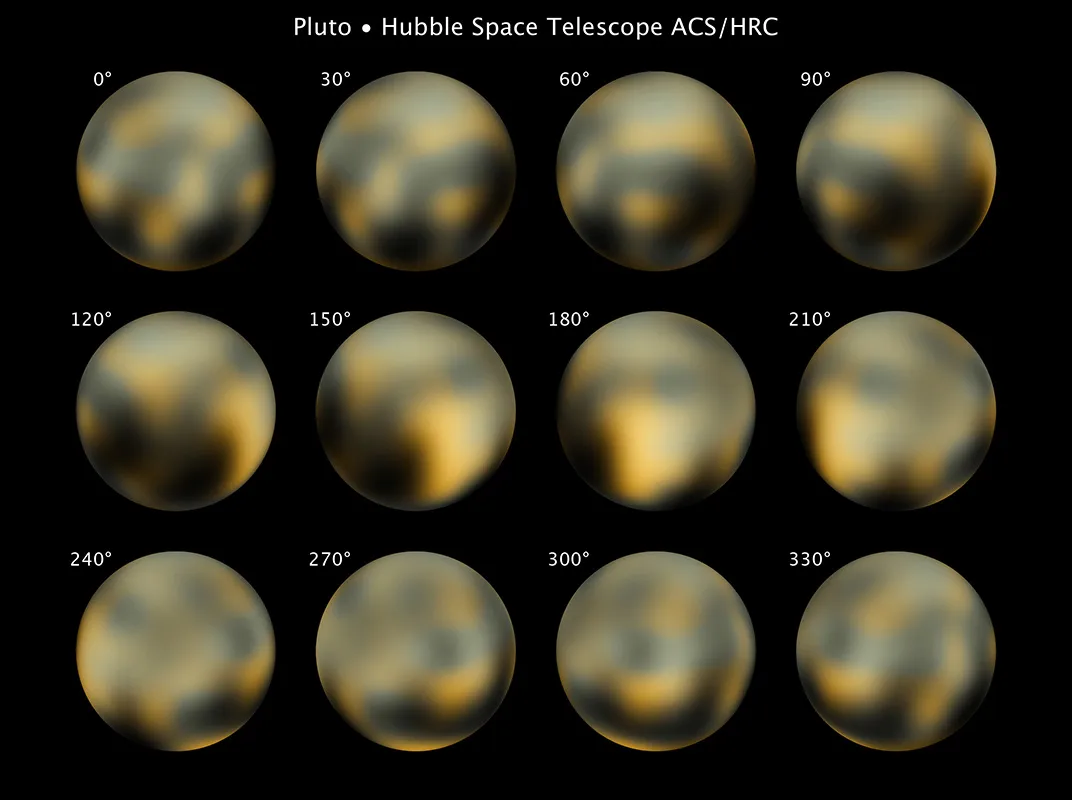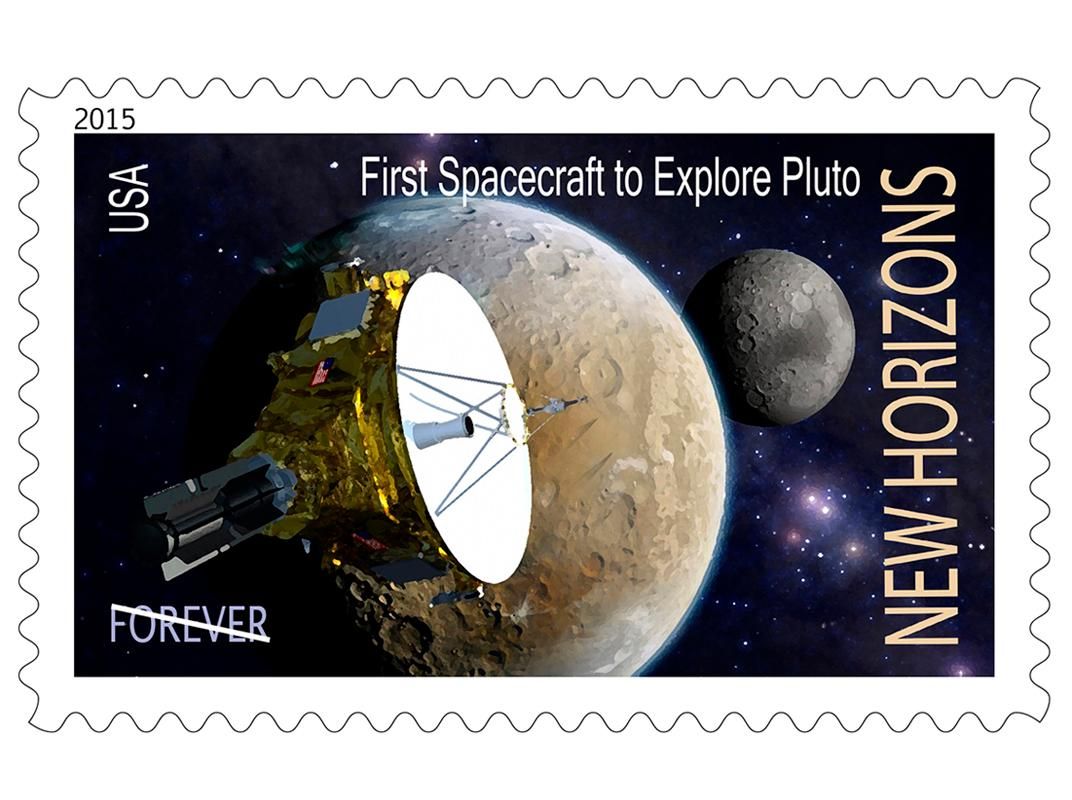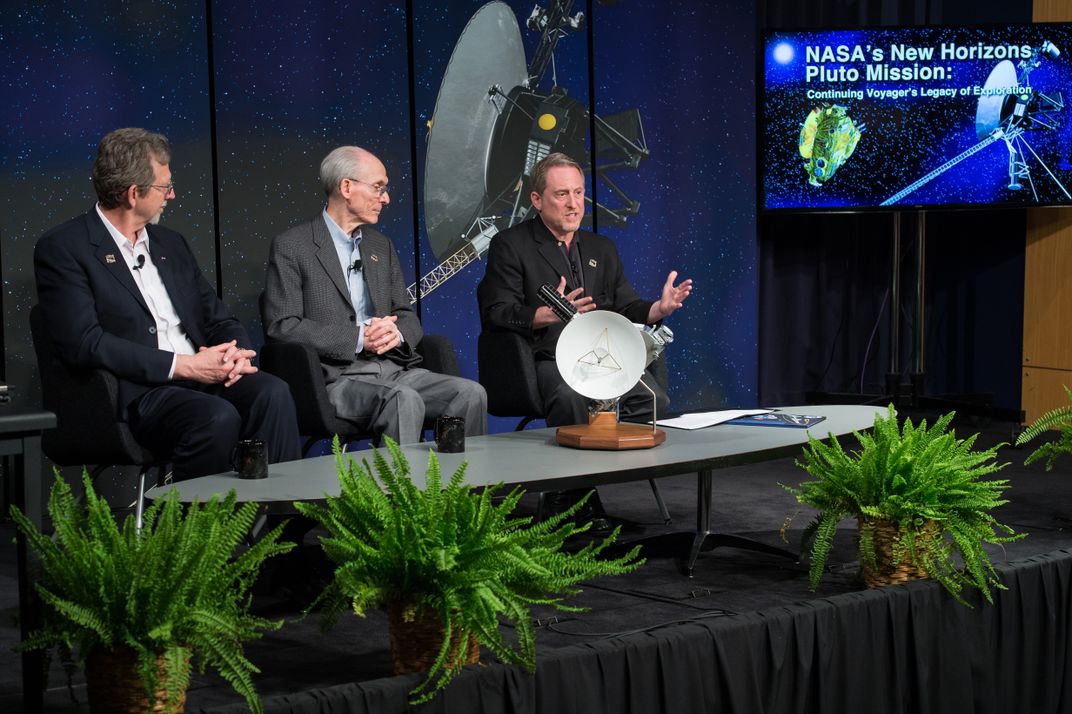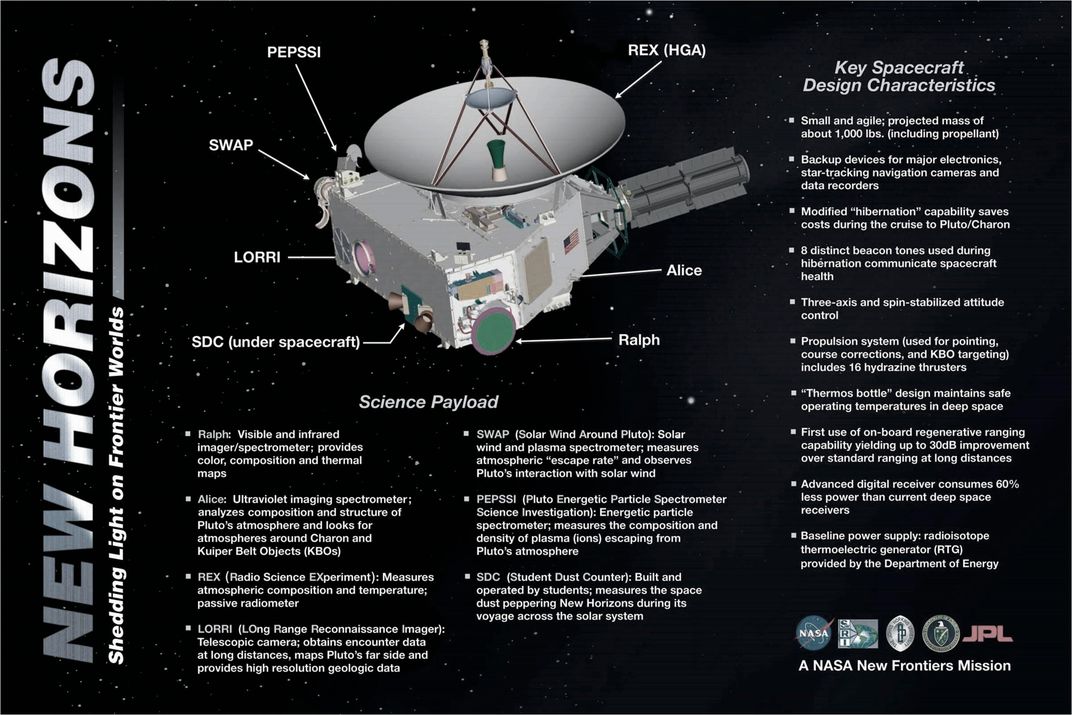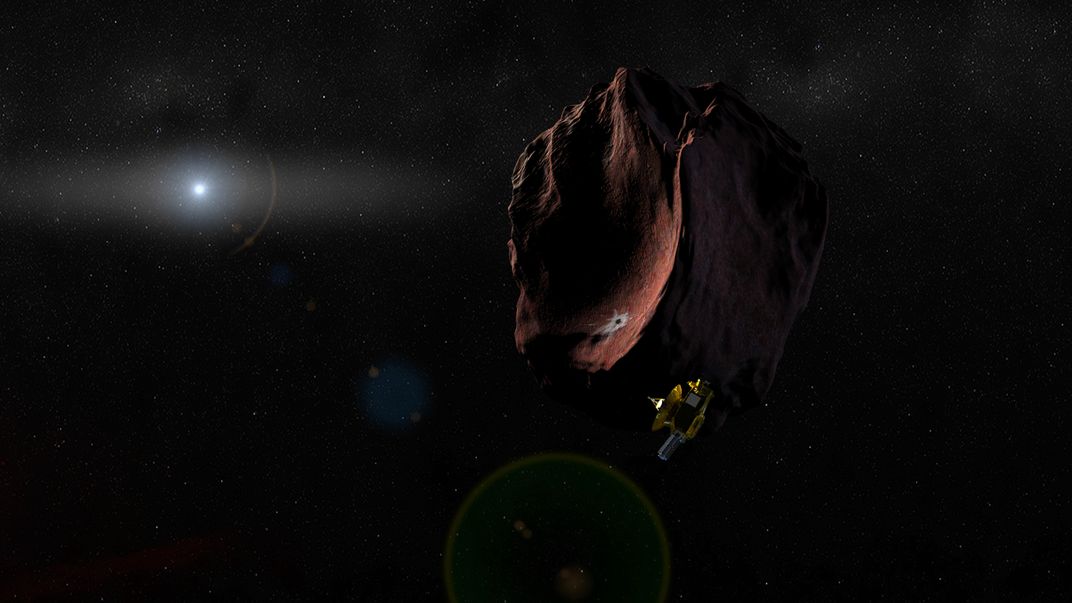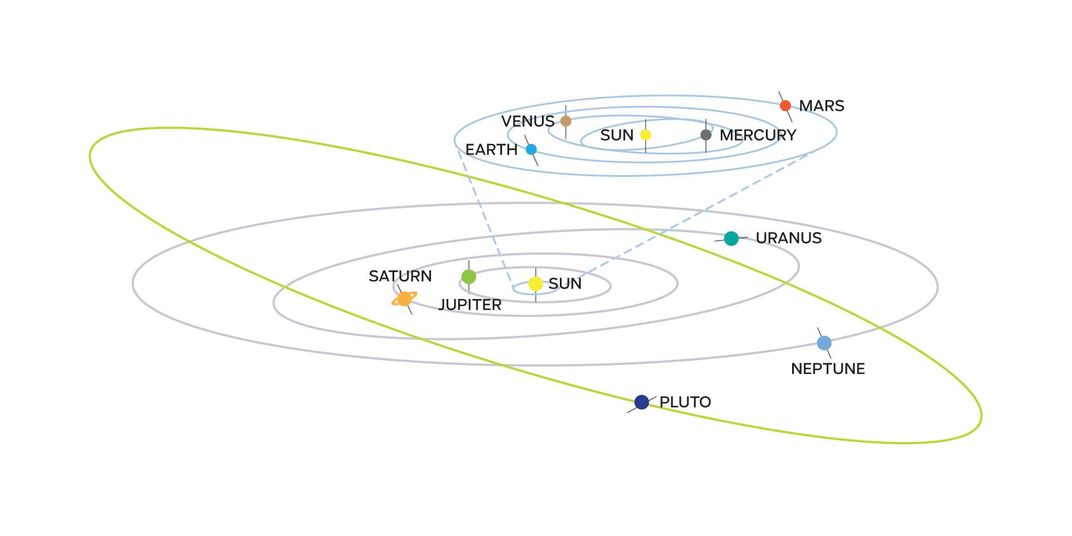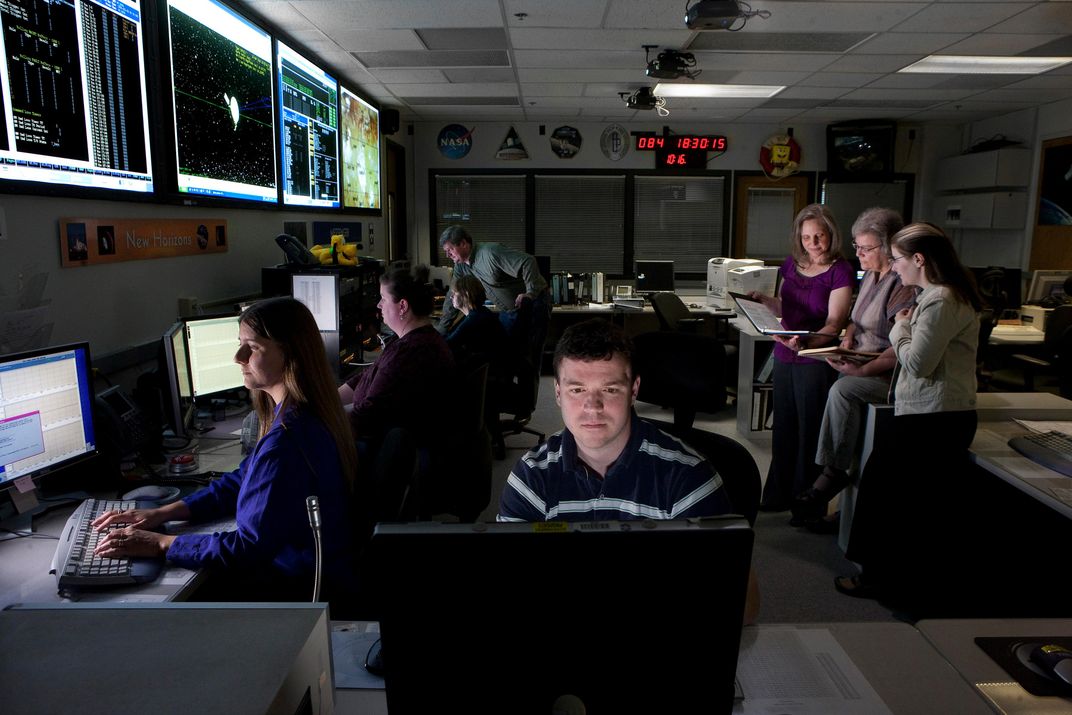Pluto at Last
Nine years after leaving Earth, New Horizons closes in on the last of the Original Nine planets, and whatever lies beyond.
/https://tf-cmsv2-smithsonianmag-media.s3.amazonaws.com/filer/be/d4/bed4dfa3-55db-45ca-a7cd-18bf96028180/15n_fm2015_plutocrescentviajhuapl_live-cr.jpg)
This July 14, at around 9 p.m. Eastern time, a burst of radio telemetry will complete a three-billion-mile trek to arrive at one of the huge dish antennas of NASA’s Deep Space Network. The signal will make its way to a command center in Maryland, where planetary scientist Alan Stern will be waiting. If the signal arrives as planned, he will know that the reconnaissance of Pluto he spent the last 25 years working toward has succeeded.
Thirteen hours earlier, the 1,100-pound, grand-piano-size probe called New Horizons will have sped past the dwarf planet and its retinue of moons, gathering close-up images and other data that Stern expects will “rewrite the textbooks.” That is, if New Horizons manages to avoid colliding with particles of dust and ice, which—at a flyby speed of 31,000 mph—could destroy the craft before it has a chance to transmit its findings to Earth. Stern, who is based at the Southwest Research Institute in Boulder, Colorado, says, “That should be a nail-biter.” He says it almost cheerfully, as if he welcomes the ordeal. By now, as the mission’s principal investigator and the driving force behind its creation, Stern is used to tension. Almost everything about getting to Pluto has been a struggle.
Twenty-five years ago, when he began his Pluto quest, planetary scientists were still anticipating the conclusion of the Grand Tour of the outer solar system by the twin Voyager spacecraft, launched in 1977. At one time planners had considered including Pluto on Voyager 1’s itinerary, but instead chose a flight path that would allow close flybys of more alluring targets like Saturn’s moon Titan. And so, after passing Saturn in 1980, Voyager 1 headed off toward interstellar space, and the Grand Tour ended with Voyager 2’s flyby of Neptune in August 1989. Most scientists were untroubled that Pluto had been left out.
Not Alan Stern. To him, the exploration of the solar system was unfinished. By the spring of 1989, with a new Ph.D. in astrophysics and planetary science, Stern was already thinking about how to get NASA to send a mission to the ninth planet. He started talking up the idea. “I was a young guy,” he recalls, “and senior guys in the field, guys that were in their 50s then, would say to me, ‘Are you kidding me? Everyone will be dead by the time we get there.’ Meaning they would be dead. It’s human nature.”
Stern rallied several young scientists, and even a few older ones, to take up the cause. The idea became even more appealing after Voyager 2’s Neptune flyby, when scientists got their first good look at the icy moon Triton, thought to be a close cousin of Pluto. Voyager’s images revealed weird, contorted terrains and, to everyone’s amazement, geysers of frozen nitrogen. There was reason to think Pluto might be just as strange and exciting.
Discovered in 1930 after a nearly year-long telescopic search by a young observatory assistant named Clyde Tombaugh, Pluto is so faint and so distant—its 248-year orbit averages 3.7 billion miles from the sun—that almost half a century elapsed before astronomers had the technology to study it. Not until 1978 did astronomers detect its Texas-size moon Charon, about half the size of Pluto itself (even now no one is sure exactly how big Pluto is, but the estimated diameter is 1,430 miles, roughly two-thirds the size of Earth’s moon). It seemed like a heroic feat in 1976 when a trio of astronomers probing Pluto’s infrared spectrum detected methane, which they deduced was frozen on its surface. Years later, scientists would learn that Pluto’s ices are dominated by even more exotic frosts of nitrogen and carbon monoxide, which exist only because temperatures on Pluto are around –380 degrees Fahrenheit.
In 1988, astronomers using an airborne NASA telescope watched Pluto pass in front of a star for five minutes, and saw the light dim not suddenly, as it would have if the planet were airless, but gradually, revealing it had a wisp of an atmosphere. Assisting with the observations was Leslie Young, who had recently earned a physics degree and was not yet in grad school. Now the New Horizons deputy project scientist, she calls that experience “five minutes that changed my life.”
As for what Pluto actually looks like, that was beyond the reach of any telescope on Earth, something New Horizons team member Marc Buie learned when he began studying the planet in 1983. By 1994 he had won observing time on the Hubble Space Telescope and, for the first time, Pluto showed its face—though just barely. Even with Hubble the planet was only a few pixels across; the best images revealed only strongly contrasting patches of bright and dark that seemed to change with time. Meanwhile, theoretical work by Stern and others suggested that the planet’s volatile surface frosts and its tenuous atmosphere were locked in a slow, complex dance, with ice continually migrating with the changing seasons, evaporating from the dimly sunlit summer pole and condensing in the Stygian darkness of the winter pole. Pluto was turning out to be not just a frozen ball, but a body much more complex than most scientists had suspected.
By that time, a revolution was under way that would reshape astronomers’ conceptions of the solar system. Searching the vastness beyond Pluto, researchers detected still more distant worlds, some of which were nearly Pluto’s size. By the end of the 1990s the scientists had realized that what they were seeing were members of an entire population—now known as the ice dwarfs—whose numbers could only be guessed at, but likely reached into the thousands. This newly discovered realm was christened for Gerard P. Kuiper, founder of the Lunar and Planetary Laboratory at the University of Arizona and widely considered the father of planetary astronomy. The Kuiper Belt became the solar system’s new terra incognita.
As for Pluto, it eventually suffered the indignity of being demoted by the International Astronomical Union (IAU) from full planet status to “dwarf planet”—a reclassification that Stern and other scientists still contest. Though many textbooks now list only eight planets in the solar system, the debate over what constitutes a “planet” continues.
Long before the controversy erupted, Stern had put a new spin on his pitch for selling the mission. Suddenly Pluto was no longer the lone misfit. He talked less about a visit to the ninth planet and more about the chance to explore the largest and most intriguing known object in the Kuiper Belt. But despite his best efforts, the projected high cost and long travel time of reaching Pluto made it a tough sell. Many planetary scientists, competing for NASA’s limited funds, withheld support. During the 1990s and into the 2000s, the space agency seemed ambivalent; Pluto kept appearing and disappearing from the roster of planned missions. Not until 2003 did NASA approve Stern’s flyby—not just of Pluto but of an additional Kuiper Belt Object (KBO) if possible. Stern named the mission New Horizons, as much for its relatively fast and low-cost development as for the places it would visit.
The relative motions of the planets made the first weeks of 2006 a critical launch window: With that timing, New Horizons could fly past massive Jupiter and get a boost from its enormous gravity, trimming the voyage from 14 years to nine and a half. Otherwise, the craft would not arrive until after 2020, when, according to some models, Stern and his team would have no chance to study Pluto’s atmosphere: By then, traveling in its highly elliptical orbit, the planet would have moved so far from the sun that its atmosphere would have frozen onto the surface.
With less than three years to design, build, and test their spacecraft, the team had their work cut out for them. “Almost everybody we knew said, ‘You will never pull that off,’ ” Stern remembers. One of the tensest moments occurred in the summer of 2004, as the Los Alamos National Laboratory was temporarily shut down in the wake of a security breach, threatening production of the plutonium that would serve as the craft’s power supply. In the end the team hit their deadline, and without major cost overruns. With evident pride Stern says, “All told, NASA spent almost $300 million studying Pluto missions over 11 years, which is actually about what it cost us to build [the hardware] in just three.”
New Horizons left Earth on January 19, 2006, boosted by a powerful Atlas V rocket to 36,000 mph, the greatest speed ever for a departing spacecraft. It crossed the orbit of the moon less than nine hours later (a fraction of the time it took the Apollo missions), and in a month little over a day it was a million miles out in space. In February 2007, half a billion miles from Earth, it raced past Jupiter and onto its course for Pluto; the flyby also served as a dress rehearsal for the team as they trained New Horizons’ instruments on Jupiter and its moons. Then, with eight and a half years still left to get to Pluto, mission controllers put the craft into a state of hibernation that would be interrupted only by yearly checkups of its systems.
During this long, silent cruise, the team has been busier than you’d expect. For one thing, Pluto and Charon turned out to have company. Even before launch, New Horizons project scientist Hal Weaver and a small team had used Hubble in 2005 to discover two satellites, each no bigger than 100 miles across, later named Nix and Hydra (the names were chosen to honor the New Horizons mission). Then, in 2011 and 2012, Hubble turned up two considerably smaller companions, Kerberos and Styx. Aside from the headaches the new satellites gave theorists who specialize in orbital dynamics—no one has yet figured out how Pluto could have ended up with this arrangement of moons—the smallness of Kerberos and Styx made them extremely worrisome to the team: Their gravity was estimated to be too weak to corral debris blasted off their surfaces by eons of impacts from passing Kuiper Belt objects, so the region around Pluto might be littered with tiny pieces of ice and rock, turning the encounter into a potential death trap for New Horizons. Explains Weaver, “If we did strike even a one-millimeter-size particle, at that kind of speed…that’s the end of the mission.”
The team spent a year and a half studying the dust hazard with mathematical models and with experiments, using hypervelocity guns at NASA’s White Sands Test Facility in New Mexico and at the University of Dayton in Ohio, that fired tiny projectiles at spare New Horizons hardware. To the engineers’ relief, the results indicated that the original flight path, chosen to maximize the mission’s science return, was also the least hazardous. Says Marc Buie, “The only less risky thing you could do is not go.”
Even so, as New Horizons closes in on its target this spring, the team will be on the lookout for additional satellites, especially those that may have spawned orbiting dust swarms. If a potential hazard is discovered more than 14 days before the July 14 encounter, there’s still time to switch to a trajectory calculated to reduce the risk. After that, the controllers could take one last emergency measure: to orient the spacecraft, some three hours before closest approach, with its seven-foot dish antenna pointed into the direction of flight to act as a shield. That would limit the highest-resolution science observations—pointing the instruments requires turning the entire spacecraft—but that sacrifice may be necessary if it enables the spacecraft to survive the encounter. Weaver is confident the reorientation won’t be necessary: “I think it’s highly unlikely, maybe a one-in-a-thousand chance, that we would end up in a situation like that. It’s much more likely that we’re going to fly through just perfectly and do the nominal plan.”
The excitement will start building this April, when the close-encounter phase officially begins. By mid-May, images from the spacecraft’s black-and-white telephoto camera will exceed the resolution of the best Hubble views. For the next two months, says Leslie Young, “every picture will be the best picture of Pluto ever.” On July 13, one day before closest approach, Stern says Pluto will look “better than the world’s best binoculars [viewing] the moon.”
On the day of that encounter, with their targets swiftly growing in their fields of view, the science instruments will make hundreds of observations of Pluto and Charon’s surface features, chemical compositions, atmospheres, and neighboring moons. Four decades after the Voyagers were built, New Horizons carries technologies that would have seemed futuristic then, like a color camera capable of 25-megapixel images and an infrared spectrometer that will map the surface compositions of Pluto and Charon in detail. Scientists have long speculated that the reddish brown of Pluto’s dark regions is produced by organic molecules created when methane ice is exposed to solar and cosmic radiation. But, as Young notes, “we’ve been telling ourselves these stories [about Pluto’s surface] for 25, 30 years.” The infrared spectrometer will finally tell them if the speculation was true.
For all of New Horizons’ sophistication, Stern and his team had to make compromises with the design to save weight and cost. In particular, the spacecraft lacks a scan platform, so it won’t have Voyager’s ability to point its antenna at Earth while gathering data. In fact, Stern says, “on encounter day, we don’t talk to or hear from the spacecraft once. It’s completely on its own. It doesn’t even check in until it’s all over.” That also prevents the team from knowing if the craft survived passage through the plane of Pluto’s satellites, where the dust hazard is thought to be greatest, until the craft sends a brief update on its health that evening. Still, Stern says, “after 25 years, we can wait another 12 hours to find out how it all went.”
New Horizons will make its closest approach, at a distance of about 6,200 miles, at 7:49 a.m. Eastern time on the 14th. Light from the sun will be nearly a thousand times dimmer than it is on Earth, so long exposures will be necessary; to avoid blurring, the spacecraft will have to rotate to track its target, a technique used when Voyager 2 took close-ups of Neptune’s moon Triton in 1989. New Horizons will be flying four times closer to Pluto, however, and its images will have more than 10 times finer resolution. The best views will show features half an acre in size.
What will we see in those images? “I don’t make predictions,” says Stern, and most of his teammates are just as reticent. By chance, New Horizons will reach Pluto 50 years to the day after Mariner 4 captured the first close-ups of Mars, images that shocked scientists with a moonlike expanse of craters on a world long thought to be relatively Earth-like. Everyone is only too aware of the many surprises from half a century of planetary exploration, from active volcanoes on Jupiter’s moon Io to braided rings at Saturn. Still, people are bound to speculate. One NASA geologist—he’d rather his name not be attached to such guesswork—thinks that if Pluto’s volatile ices really are evaporating away from the sunlit northern hemisphere, the process may have created a spectacular landscape of cliffs and mesas resembling a deep-freeze version of Arizona’s Monument Valley. Others venture that there could be signs of a subsurface ocean like those believed to exist within some of the icy satellites of Jupiter and Saturn. And the team will also be looking for geysers like Triton’s—although spotting them might take some luck, since half of Pluto will be shrouded in darkness.
Speeding away from its encounter, New Horizons will look back to watch Pluto and Charon eclipse the sun, providing a brief opportunity for the instruments to peer through the bodies’ atmospheres and study their structures, temperatures, and pressures. The spacecraft will also glimpse Pluto’s night side in the dim light reflected from Charon, with about the same resolution as a naked-eye view of the moon from Earth—enough to tell whether fresh ice has begun to accumulate at the winter pole.
If New Horizons does survive its passage through the Pluto system, a pre-selected sample of encounter data will begin arriving at Johns Hopkins University’s Applied Physics Laboratory in Maryland at around 7 a.m. on July 15. This batch, including what are anticipated to be some of the most dramatic images—what the team calls their “New York Times dataset”—will be sent in slightly compressed form to speed the transmission. Even so, because of the enormous distance and the relatively small size of the spacecraft’s antenna, the data will trickle in at just 2,000 bits per second, slower than a 2400-baud modem from the 1980s.
For safety’s sake, New Horizons will spend the following two months sending back all the encounter data in compressed form, making the pace of discovery seem more like that of an orbiter mission than a one-time flyby. Then the craft will re-transmit everything in its full, uncompressed state, a process that won’t be complete until the fall of 2016.
By then, New Horizons will be a little more than two years from another flyby, this one within the Kuiper Belt itself. Finding a post-Pluto target that the craft could reach with its limited fuel budget turned out to be a challenge; several years of searching with ground-based telescopes came up empty. Then, last summer, Hubble came to the rescue: The team was awarded a whopping 202 orbits of time on the spaceborne observatory to search for a target. In October, they announced they had found what they were looking for: two tiny worlds, each less than 35 miles across and roughly a billion miles beyond Pluto. For now, the objects are just called PT1 and PT3. Pending a decision in August, sometime this fall New Horizons could fire its engine to adjust its path for a rendezvous with one of them in 2019.
“We launched going to two Kuiper Belt objects, Pluto and Charon,” says Young. “We’re now planning for sure to fly past six Kuiper Belt objects: Pluto, Charon, and the four small moons. To be able to pick up another one that was in a whole different environment is going to be fabulous.”
For now, the team is focused on the coming exploration of a world that has captivated them for decades. Young says she’s most looking forward to “being confused and then not being confused—having the first set of data come down, and we wonder, ‘Why does it look the way it does?’ And then, as we tease out the rest of the data…learning something fabulous and new about Pluto” and the Kuiper Belt.
For Alan Stern, this is more than the end of a 25-year quest. It’s a chance to excite the public with an experience he says has been missing since the last Voyager encounter. “It’s raw exploration,” he says. He’s looking forward to sharing with the world “how exciting it is to turn a point of light into a planet before their very eyes.” And soon, if all goes well, a student in science class will open a textbook and see a clear picture of Pluto.
